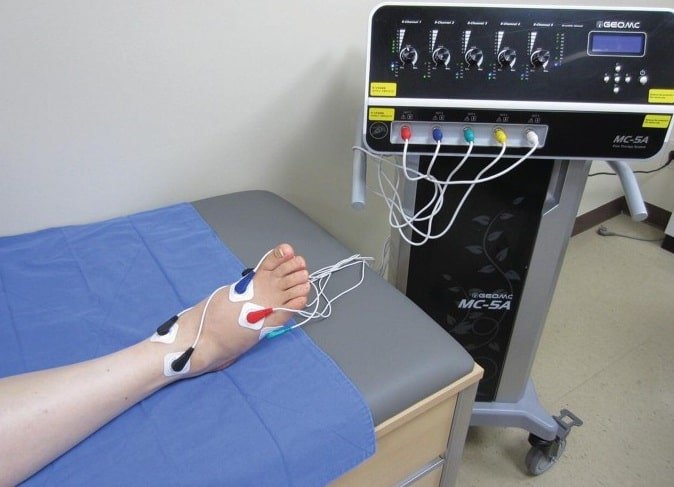can calmare therapy help sci patients
TheraMediCare.com – Spinal cord injuries (SCI) often lead to neuropathic pain, a complex, chronic pain state. This pain can be debilitating, affecting the quality of life of patients. Traditional pain management methods often fall short. They may not provide adequate relief, and can lead to dependency or adverse side effects. Enter Calmare therapy. This non-invasive treatment has shown promise as an alternative pain management strategy. It’s particularly relevant for SCI patients seeking neuropathic pain relief. This article explores the potential of Calmare therapy for SCI patients. We delve into its mechanism, effectiveness, and sustainability. We also compare it with traditional pain management methods. We’ll discuss its cost-effectiveness and the impact on patient outcomes.

Join us as we navigate the landscape of pain management. Let’s explore how Calmare therapy could revolutionize the way we approach neuropathic pain in SCI patients.
Understanding Spinal Cord Injuries and Neuropathic Pain
Spinal cord injuries interrupt the communication between the brain and body. This disruption can lead to severe complications, including neuropathic pain.
Neuropathic pain occurs when nerves in the spinal cord and brain misfire. They send pain signals even in the absence of injury.
SCI patients frequently experience this type of pain. It can manifest as burning, tingling, or shooting sensations.
The prevalence of neuropathic pain among SCI patients is high. It contributes significantly to their emotional and physical suffering.

Traditional treatment options often fall short. They fail to provide long-lasting relief without causing side effects. SCI patients and healthcare providers alike seek better solutions to manage this challenging pain type. Through this article, we will explore how Calmare therapy could be a promising alternative.
What is Calmare Therapy?
Calmare therapy, also known as Scrambler Therapy, is a non-invasive treatment. It aims to alleviate chronic neuropathic pain by using electrical stimulation.
The device used in this therapy transmits low-level electrical currents. These currents are interpreted by the nervous system as non-pain signals.
Calmare therapy offers several advantages:
- Non-invasive and drug-free
- Minimal side effects
- Suitable for various types of neuropathic pain
Its technology mimics normal nerve signals. This can disrupt pain signal transmission to the brain, offering relief.

As a non-drug alternative, it represents a shift in pain management strategies. Healthcare providers can find its applications valuable in settings where traditional methods fail.
The Mechanism Behind Calmare Therapy
Calmare therapy functions through a unique mechanism that targets pain at its source. By using electrostimulation, the therapy intercepts pain signals.
The device delivers these signals at the surface of the skin. Electrodes placed on the skin send these signals to the affected area.
This creates what is known as a “no-pain” message. These messages travel along the same nerve pathways as pain, effectively scrambling the pain signals.
As the brain interprets these scrambled signals, the sensation of pain diminishes. This process can offer significant relief to patients.

By modifying how pain is perceived, Calmare therapy provides an innovative solution. It changes the narrative for individuals with long-standing neuropathic discomfort.
Calmare Therapy for SCI Patients: How It Can Help
Spinal cord injury (SCI) patients often struggle with chronic neuropathic pain. This pain can severely affect their quality of life.
Calmare therapy offers a non-invasive alternative. It provides relief without relying on medications.
For SCI patients, Calmare therapy can address pain at its root. This approach bypasses the need for drugs with side effects.
Many SCI patients face challenges with traditional pain management. Calmare therapy presents a fresh perspective on care.
Key benefits for SCI patients include:
- Reduction in persistent neuropathic pain
- Decreased dependency on opioids
- Enhanced quality of life
Healthcare professionals can integrate Calmare therapy seamlessly. It fits within existing treatment plans without major adjustments.
Case studies highlight patient success stories. Many report life-changing reductions in pain levels.
By offering a sustainable option, Calmare therapy aligns with modern healthcare goals. It emphasizes patient-centered, holistic care.

Comparing Calmare Therapy with Traditional Pain Management Methods
Traditional pain management for SCI often involves medications. These include opioids and other pharmaceuticals. While effective, they come with significant side effects.
Opioid reliance can lead to addiction or tolerance. Patients may need increasing doses for relief. This poses risks and challenges.
Calmare therapy, in contrast, avoids these pitfalls. It provides pain relief without pharmaceuticals. Its non-invasive nature is a distinct advantage.
Moreover, Calmare therapy offers targeted pain management. It addresses neuropathic pain specifically, unlike broad medications. This precision enhances treatment efficacy.
Integrating Calmare therapy requires minimal disruption. It complements existing care plans and fosters comprehensive patient care.
The Sustainability and Cost-Effectiveness of Calmare Therapy
Calmare therapy offers notable sustainability benefits. It minimizes medical waste due to its non-invasive nature. This aligns with eco-friendly healthcare practices.
Cost-effectiveness is another key advantage. Traditional treatments often incur high ongoing costs. Calmare therapy requires fewer resources over time.
Reduced reliance on medications cuts expenses. Patients can avoid the financial burden of continuous drug use. Insurance coverage for non-pharmacological treatments is also improving.
Consider these sustainability advantages:
- Decreases in medical waste and resource usage
- Reductions in long-term healthcare costs
- Fewer side effects lead to less follow-up care
Overall, Calmare therapy presents a viable, sustainable option. It promotes both patient well-being and environmental responsibility.
Patient Outcomes and Testimonials
Many SCI patients report positive results after using Calmare therapy. They experience significant neuropathic pain relief. Such improvements enhance their overall quality of life.
Numerous testimonials highlight lasting pain reduction. Patients often express satisfaction with the treatment’s effectiveness. This improvement boosts their mental health and daily functioning.
Case studies frequently demonstrate these benefits. For instance, patients who tried traditional methods found Calmare therapy superior. They note reduced pain without the unwanted side effects of medication.
The therapy aids in decreasing opioid dependence. Patients who might otherwise rely on painkillers benefit greatly. This change promotes healthier lifestyles and long-term well-being.
The growing body of patient testimonials supports Calmare therapy’s credibility. These firsthand accounts encourage healthcare providers to consider it. As more success stories emerge, confidence in this innovative treatment builds.
Clinical Evidence Supporting Calmare Therapy for Neuropathic Pain Relief
Clinical studies confirm the effectiveness of Calmare therapy. These studies emphasize its role in neuropathic pain relief for SCI patients. Many reputable research institutions have conducted these studies, strengthening its validity.
Research shows a significant decrease in pain scores. Patients report improved symptoms after consistent therapy sessions. Such results indicate a promising alternative to traditional pain management.
Peer-reviewed journals frequently publish findings on Calmare therapy’s benefits. These publications underscore its scientific credibility. This recognition encourages more healthcare professionals to explore its potential for their patients.
Further evidence from trials highlights its safety and efficacy. Minimal side effects enhance its appeal over pharmacological approaches. This is crucial for patients seeking non-invasive treatment methods.
The growing body of clinical evidence supports expanding the use of Calmare therapy. Healthcare providers can trust its documented benefits. This evidence base fosters optimism in improving patient outcomes.
Integrating Calmare Therapy into SCI Patient Care
Integrating Calmare into SCI patient care requires a well-coordinated approach. It involves collaborative efforts from various healthcare professionals. Each plays a critical role in the patient’s recovery journey.
First, healthcare providers need proper training to administer the therapy. Understanding the device and its protocols ensures effective application. Education is key to maximizing treatment benefits.
Consider creating personalized treatment plans. These plans address the unique needs and pain levels of each patient. Tailored approaches enhance the therapy’s effectiveness and patient satisfaction.
Successful integration also involves monitoring patient progress. Regular assessments help tweak the therapy as needed. Continuous feedback ensures the treatment aligns with the patient’s evolving condition.
Integrating can include:
- Initial assessment by a multidisciplinary team
- Training for healthcare providers
- Personalized treatment plans
- Ongoing progress monitoring and adjustments
- Patient education and feedback
With thoughtful integration, Calmare therapy can meaningfully contribute to SCI care.
The Future of Pain Management: The Role of Calmare Therapy
The landscape of pain management is evolving rapidly. Innovative approaches like Calmare therapy are shaping this future. They offer promising new directions for treatment.
Calmare therapy stands out for its non-invasive nature. Its potential to reduce reliance on opioids is significant. This makes it a compelling option for clinicians.
The therapy is part of a growing trend towards patient-centered care. It allows patients to play a more active role in managing their pain. Empowering patients in this way can improve outcomes.
As research progresses, the efficacy of Calmare therapy continues to gain validation. Ongoing studies explore its broader applications. These efforts will enhance our understanding and refine its use.
The future will likely see Calmare therapy integrated into comprehensive pain management programs. Its potential to improve quality of life for many patients is immense. We must embrace and nurture such innovation.
